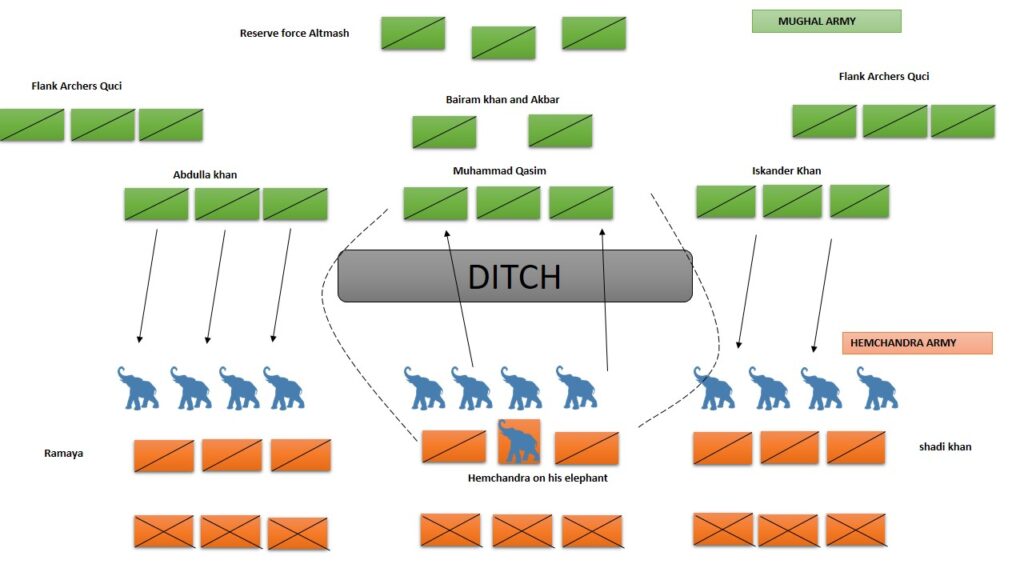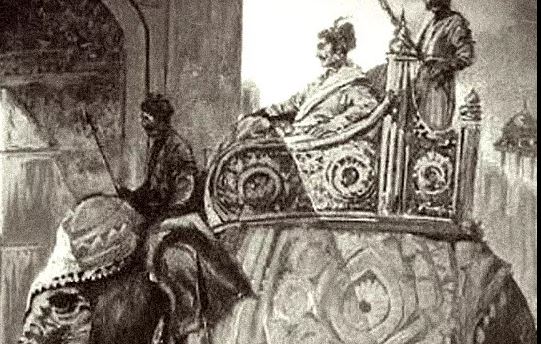Hemu / Hemchandra or Hemu Vikramaditya (Brahmin) was one of the greatest Indian military minds of medieval Indian history. From winning 22 battles to declaring himself the independent Hindu King of Delhi (Hemu the last Hindu king of delhi), his life story is filled with many heroic chronicles which ultimately lead him to become one of the biggest Indian medieval history heroes. Here is the detailed story of the second battle of panipat, which Hemu fought against the Mughal Forces of Akbar..
Content
Rise Of The Vikramaditya – How Hemu rose to power from very humble beginnings
Hem Chandra ( belonged to Dhusar brahmin community) was born in Alwar district of Rajasthan. Being born in a hindu family of limited means,he sold vegetables and saltpeter (potassium nitrate ,used for making gun powder) from very young age. No one knew who was Hemu at this point and how this man would change the course of Indian History.

Hemu developed interest in the armed services and due to his discipline and loyalty towards tradework in the market sector, along with his wide knowledge of use of weapons he quickly became a recognized personality locally.
On the other hand Islam Shah, the son of Sher shah rose to power and become ruler of Sur dynasty.He was known for appointing Hindus and afghans in the army together as they used to spy on each other and traitors were exposed effortlessly. He was impressed by Hemu’s soldierly qualities and made him the superintendent of Market to ensure supplies to entire afghan army.
Later Adil shah, the successor of Islam shah appointed Hemu as his prime minister and commander in chief of the Afghan army. This was a big deal for Hemu. But he soon proved his worth.
After becoming commander in chief ,Hemu successful defeated Sultan Muhammed the ruler of Bengal. Prior to Panipat Hemu had fought and won 22 battles which further increase his reputation among the Sur dynasty.
Hemu further increased his power by recruiting his nephew Mahipal and Ramaya in the Afghan army.
Mughals after 1st panipat
Meanwhile After 1st winning the first battle of Panipat , Babur fought several other battle to further enlarge his empire. The battles were as follows:
- 1 Battle of Khanwa- in 1526 against Rana Sanga of Mewar
- 2 Battle of Chanderi – in 1528 against Medini Raj of Malwa
- 3 Battle of Ghaghra- in 1529 against the Afghans
The Mughals were victorious in all of them. Soon after these battle Babur died in 1530 and his son Humayun ascended the throne.
Emperor Humayun was an accomplished mathematician and astronomer but he is considered as the most unfortunate Mughal emperor. Humayun was defeated in the battle of Chausa( 1539) and in the battle of Kanauj by Shershah suri, who founded the Sur dynasty.The period of 1540-1555 is known as the period of temporary darkness for the Mughals.
Humayun invade India in 1554 and occupied Delhi in 1555. But Humayun died 6 months after capturing Delhi on 24 January 1556. Akbar , then aged only 14 years became his successor, which gave Hemu an ideal opportunity to attack Mughals. The stage was set for the biggest and most decisive battle of Hemu’s Life.
The Battle
Initial Engagement of the two armies :
On Bairam khan’s order (military commander of the Mughal army) ,Tardi Beg Khan governor of Delhi move towards Agra while Hemu moved form Chunar(U.P) and the stage was set for the battle of Delhi.
In the battle ,Hemu defeated the Mughals and captured Delhi. For the first time in more than 300 years Delhi again fell under a Hindu king.

source: wikipedia
Hemu the last Hindu king of Delhi
Hemu introduced coins in his name and crown himself as independent Raja VIKRAMADITIYA a name that had been adopted by many Hindu kings in the past (Bikramaditya) and thus came to known as Hemchandra Vikramaditya. It was seen as a hope for the revival of traditional Indian/Hindu monarchical order , something that Delhi had not seen in centuries.

Final Showdown at Panipat
After losing Delhi, Bairam khan reorganized the Harwal-i-manqula(deep penetration strike force). The Mughals put their experienced soldiers and introduced a new unit named as Altmash(a reserve force behind the centre of Mughal army).They also develop flank archers known as Uqci.

Mughals deployed their vanguard under Muhammad Qasim, the left wing was under Iskander Khan and right wing was under Abdulla khan. The Mughal dug a ditch to protect their central wing.
Their main aim was to implement their famous Tulghama tactics as they did under Babur in first battle of panipat.
On the other hand ,Hemu deployed his army in the same formation as he did in the battle of Delhi. He placed elephants in the vanguard, cavalry in the first line and infantry in second line.
Iskander khan and Abdulla khan charged hemu’s right and left wing. Muhammad Qasim ordered his horse archers to target the legs of Hemu’s war elephant.
How Hemu outsmarted the Mughals in the battle of Panipat
Hemu was aware of Mughals tulghama tactics and immediately order his both flank for a tactical retreat to isolate Mughal center. When mughal center under Shah Ali Quli became isolated Hemu ordered his elephant units to smash the Mughal’s center.
The ditch provided some resistance but after a while Hemu’s elephant unit were able to cross the ditch. The charge of the elephants created panic among the Mughal army.
Hemu’s soldiers were able to break the mughal formation and their tulghama tactics and the mughal line was on the verge of collapse.
Hemu’s unfortunate demise and the ending of the battle
By now, the elephant units of Hemu had broken the Mughal Formation and were creating mayhem among the troops. It was looking like Hemu would win the battle. But suddenly an arrow( probably from mounted archer) hit Hemu’s right eye. Due to continuous loss of blood, Hemu lost consciousness. The Mughals immediately surrounded Hemu’s elephant and captured him. Seeing this Hemu’s soldiers lost their motivation and started to retreat.
Mahipal, Shadi khan, Ramaya were all killed during the retreat thus ending the 2nd battle of panipat.
The Mughals made pyramid with the skulls of Hemu’s soldiers in the same way as Babur did in the first battle of panipat.
Hemu’s hand were tied and brought before Akbar(only 14 years old) and Bairam khan. On Bairam khan’s order , Hemu was beheaded and his head less body was hanged on a gate in Delhi. The wining army had lost the battle.
Aftermath of the battle and its significance in Indian History:
Hemu’s heroic life story , particularly how he rose from humblest of beginnings to the greatest millitary general at the time is considered a notable turning point for Hindu resurgence in the Indian subcontinent. If it had not been for that arrow that had hit him, Hemu would have most probably won the battle and furthered his empire beyond Delhi.
He could have bought the restoration of the traditional HIndu Rule in India,which at this point had been ruled by outsider Muslim Invaders for centuries.
Hemu is immortalized by Hindus in numerous monuments and memorials, the most famous one being at Panipat. Even the enemies Hemu had were always in great admiration of the Vikramaditya and his millitary genius and long track record of victories. Most of his life’s achievements are written in history by Mughal historians . Such was the grandeur of the Great Hemu- the last Hindu King of Delhi.
Donate to our Cause
If you Support what we are doing and would like to contribute to help us grow and reach more Indians to teach them more about such forgotten historic Indian Heroes and stories, please consider donating any amount. It will help us grow

